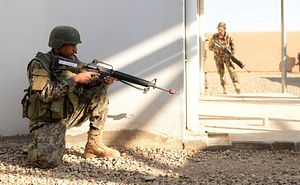Earlier this week, the Taliban posted a report to their website enumerating, in detail, which districts the group controls and contests in Afghanistan. The report, titled “Percent Of Country Under The Control Of Mujahedin of Islamic Emirate,” as Bill Roggio writes for the Foundation for Defense of Democracies’ Long War Journal, “may be seen as propaganda,” but “it does not inflate or exaggerate the Taliban’s control of districts centers and contested areas throughout the country,” in comparison to FDD’s data.
Borrowing FDD’s terminology and breakdown: The Taliban claims to fully control 34 districts, contest 167, maintain a significant presence in 52 districts, a minimal presence in 6 districts and no presence in 89 districts.
This data doesn’t quite match up with claims made by U.S. forces and the government of Afghanistan, as reported in the Special Inspector General for Afghanistan Reconstruction (SIGAR)’s latest quarterly report, which states that while insurgents control 9 districts and influence 32, 133 districts are “contested.” As for the government of Afghanistan, the SIGAR report says it controls only 83 districts and influences 150.
Differences in perspective, timing and terminology aside, the overall trajectory remains grim. The SIGAR report noted that according to U.S. forces in Afghanistan, from August 30 to November 15, 2016 alone, the number of districts under insurgent control or influence rose 2 percent and the number of contest districts rose 4.2 percent.
Moving beyond the numbers, FDD’s map is worth taking a closer look at. The districts the Taliban says it controls are clustered, with a significant number in the south and west, including large portions of Helmand, Nimroz, Uruzgan, Zabul, Ghazni, and Farah.
The north is also seemingly heavily contested, particularly along the Turkmenistan border.
This reinforces what I (and Bruce Pannier) have written recently that not all is as quiet along the Turkmen front as Ashgabat likes to say. Maybe the Taliban aren’t looking north, and maybe — as a former Afghan minister recently claimed — the Turkmen are selling weapons to the Taliban to keep them happy and content on their side of the border.
Turkmenistan has an overriding economic interest in stability in Afghanistan but perhaps not an overriding preference for whose stability it is. The planned route for the Turkmenistan-Afghanistan-Pakistan-India pipeline follows the Herat-Kandahar highway through Afghanistan’s Herat, Farah, Helmand and Kandahar provinces. The splash of black districts (those the Taliban claims to control) in southwestern Afghanistan lays along that same road.
Ashgabat may be taking solace in the Taliban’s pledge, made last December, not to attack infrastructure projects in Afghanistan, including TAPI. Turkmenistan has a serious economic need to lengthen the list of countries to which it exports gas. At present, nearly all of the country’s exports are to China. The Taliban’s pledge may prove thin, if serious work on the pipeline ever begins.

































